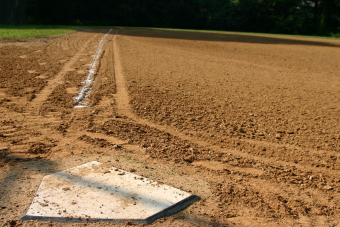Why is Home Plate in Baseball Shaped Differently Than the Other Bases?
 Oftentimes the most exciting part of a baseball game is the competition between the pitcher and the batter. The pitcher stares down the batter as he adjusts his grip on the ball and prepares for the most perfect pitch his arm can throw; the batter returns the pitcher’s glare as he holds the bat loose in his hands and anticipates his hit. In the early years, rules surrounding pitchers and hitters were loose at best. But as the game progressed, so did the rules.
Oftentimes the most exciting part of a baseball game is the competition between the pitcher and the batter. The pitcher stares down the batter as he adjusts his grip on the ball and prepares for the most perfect pitch his arm can throw; the batter returns the pitcher’s glare as he holds the bat loose in his hands and anticipates his hit. In the early years, rules surrounding pitchers and hitters were loose at best. But as the game progressed, so did the rules.
Pertinent to the topic at hand, home base went through three major shape changes over the years.
To begin with, prior to 1899, the rules regarding home plate were extremely loose. Any object round in nature could serve as home base. During this time when shape was what mattered most, the circular object used could be made of marble, stone, glass(!), or any other materials. At times, even a dish served as home base, which some think may have led to the alternate name–home plate.
In 1899/1900, the rule regarding home plate’s shape changed, requiring the base to be square in shape, as opposed to circular, so it matched the rest of the bases. The 12″ x 12″ square (later to become a 16″ x 16″ square) was positioned so one corner pointed toward the pitcher and the opposite corner pointed toward the catcher. As a result, the inner and outer edges of the strike zone were determined by the other two corners of the base.
In addition, this now square base was made out of stone or marble, with edges occasionally sharp enough to slice skin. (Not surprisingly, sliding into home plate didn’t become popular until after rubber was adopted as the standard material for home base.) If all this wasn’t bad enough, it wasn’t that many years before this that catchers did not wear any sort of glove when receiving pitches. (See: The Real First African American to Play in the Major Leagues) Rough sport.
This brings us to the irregular pentagon shape of home base that we know and love today. This was developed by Robert Keating and introduced as a viable option for the 1900/1901 baseball season. The rear corners, which extend to a point, are made to be perpendicular to the first and third base lines. The biggest advantage of the new shape was that it made the edges of the strike zone more visible to pitchers and umpires and, therefore, improved the consistency of calling strikes.
Beyond the shape, although rubber had been occasionally used prior to this, the new design specifically required home plate be made of rubber. Keating’s reasons for picking rubber here were that the springy nature of a rubber base would give base runners a bounce to their step when they took off for first base; it would not harshly vibrate the batter’s hands when he struck the base with the end of his bat; and it would prevent severe injuries from occurring when base runners slid into home.
So, in the end, home base is primarily shaped differently than the other bases because its purpose is different. Whereas other bases are used primarily for base runners, home plate has an added use in being essential in determining the strike zone.
If you liked this article, you might also enjoy our new popular podcast, The BrainFood Show (iTunes, Spotify, Google Play Music, Feed), as well as:
- How Baseball Groundskeepers Achieve Checkerboard Patterns in the Ballpark Grass
- Why Do Baseball Managers Wear the Team’s Uniform Instead of a Suit Like In Other Sports?
- A Brief History of Spring Training
- Who Invented the Sporting Wave?
- The First Person to Play for Both Baseball’s National League and American League All-Star Teams was a Woman: Lizzie “The Queen of Baseball” Murphy
Bonus Facts:
- Robert Keating was an amateur pitcher for the Baltimore Orioles. His less than stellar performance in the single game he pitched for the Orioles did nothing for his baseball career, especially since an arm injury ended his days as a pitcher- but not the impact he had on the game. Off the field, Keating became an inventor. Best known for his shaving devices, bicycle wheels, and motorcycles, Keating also, as mentioned, developed the irregular pentagon-shaped home base. Despite this, in Keating’s January 21, 1922 New York Times obituary, his contributions to baseball, both on and off the field, were not mentioned.
- Although the irregular pentagon shape of home plate is functional and was designed to improve the game of baseball, it has been noted that the shape of “home” plate (seemingly coincidentally) resembles that of a house.
| Share the Knowledge! |
|




